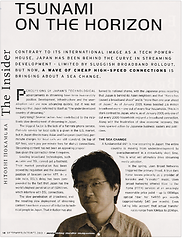Elizabeth Dykstra-Erickson
Generic Media Publishing Service
The Brief:
Content hosters must optimize their media to be compatible with new codecs and players, requiring them to maintain multiple copies to different specifications. Reduce the storage need by creating a just-in-time system to transcode in realtime, on demand, reducing effort and increasing flexibility. Make sure that distribution of assets can be controlled from global to regional markets to individual users, with realtime branding overlays per group.
The strategic issues:
-
Business-to-business applications need to be easy to use and get the job done, but they also need to make it obvious how new processes are making or saving money.
-
Changing an established media company's workflow can be difficult - especially if you are a startup! The flows have to be familiar and meaningful.
-
Try-before-you-buy is critical, but the infrastructure needed to support trials is costly, making it difficult to create meaningful demos
-
Use common design patterns to minimize the learning curve. Uses want to get work done efficiently without help.
The result:
The system received a lot of attention in the press. It was used by Yomiuri Shimbun, a media-rich news corporation in Tokyo, as a trial. Sony then purchased the system.




Step 1. Clarify the vision

In the year 2000, viewing media was still difficult, complex, and unreliable. The workflow for optimizing online media was labor intensive and often required maintaining multiple versions of each item. The complexities and costs of hosting, distributing, and consuming media limited the growth of online media. Our vision was to simplify the preparation of content for distribution, and simplify the end user experience to get the best possible viewing result with minimum effort.
The Generic Media Publishing System intent was to change the workflow for optimizing and maintaining media assets, and make it easier to update content to new codecs and user expectations. The concept of 'generic' was illustrated in the barcode-styled logo and all of Generic's assets: humble and kind technology at your service. Consumer products were more colorful and playful.
Step 2. Chart the course
I reviewed several database applications, media applications, program guides, tools that handled very large numbers of records and offered users ways to manage and organize content. We arrived at a general view of the system, and I built a flow chart to document my understanding. We continued to add to the flowchart as the project proceeded.
We had three sets of stakeholders: the content managers who would directly use the system; end users who would use the results of the system; and customers who needed to track and manage their asset distribution costs. The IT administration aspects of the server farm are not within scope of the flow.


